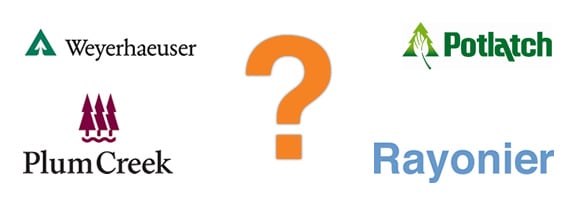Forisk Equity Research completed a comparative analysis of timber REIT forest harvesting activities to address the question, “who wins as housing markets return?”
Executive Summary
While US annual housing starts declined 72% between 2005 and 2010, timberland-owning REITs – Potlatch (PCH), Plum Creek (PCL), Rayonier (RYN) and Weyerhaeuser (WY) – deferred forest harvests and shifted harvest mix away from sawtimber (the logs for manufacturing lumber and building houses) towards pulpwood (the raw material for paper and paperboard), where pricing and demand remained relatively stable. While summarizing the overall exposure to housing markets across firms, this technical note focuses on volumes and product mix from forest operations. Unlike capacity rationalization decisions associated with manufacturing, which reduce the capacity to produce volume in the future, forest harvest deferrals effectively increase capacity to produce in the future as trees continue to grow.
The REIT structure optimizes income from timberlands, with respect to taxes, under current IRS code. As such, timber REITS emphasize the centrality of timberlands and forest products to their businesses. However, less than 50% – in cases, much less – of firm revenues derive from timber sales. Rather, direct exposure to housing – as measured by revenues from Timber, Wood Products and Homebuilding segments –> exceeds 60% of revenues for three of four REITs. However, these exposures represent distinct amalgams of regional timber harvesting, forest products manufacturing, homebuilding and real estate activities.
In assessing the future operating performance of timber REIT equities as housing recovers, we analyzed potential revenue implications from (1) direct exposure to housing markets; (2) the capacity to increase harvest volumes; and (3) the ability to improve harvest mix. Weyerhaeuser and Potlatch, followed by Plum Creek, have the highest direct exposure to, and potential revenue growth from, improved housing markets. Within this group, Weyerhaeuser’s operating exposure runs deepest across the housing supply chain.
What is the implied value impact from shifting mix relative to deferring volume for timber revenues? Each per-unit shift in harvest mix has twice the timber revenue impact, at minimum, as each per unit change in volume. In other words, holding all else constant, twice the revenue upside exists from increasing sawtimber percentages than from increasing volumes harvested. That said, the four timber REITs exhibit different combinations of volume-versus-mix upside from timber harvesting revenues.
While timber revenues will increase for all timber REITs from increased harvesting, Weyerhaeuser will lead on an aggregate and relative basis, assuming no significant change in timberland acres owned across companies. Also, with its ongoing sawtimber heavy mix and focus on logs for export markets, which command premium prices relative to domestic markets, Weyerhaeuser has a higher revenue upside potential.
Alternately, Rayonier retains the greatest potential for increasing mix-driven margins from timber harvesting. However, at the firm level, this benefit has modest implications as Rayonier derives most of its revenue from its Performance Fibers segment.
This content may not be used or reproduced in any manner whatsoever, in part or in whole, without written permission of LANDTHINK. Use of this content without permission is a violation of federal copyright law. The articles, posts, comments, opinions and information provided by LANDTHINK are for informational and research purposes only and DOES NOT substitute or coincide with the advice of an attorney, accountant, real estate broker or any other licensed real estate professional. LANDTHINK strongly advises visitors and readers to seek their own professional guidance and advice related to buying, investing in or selling real estate.










Add Comment